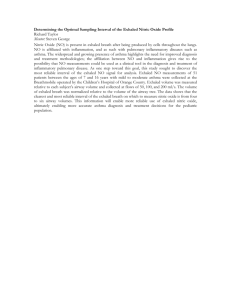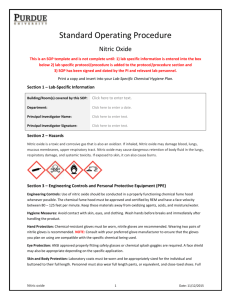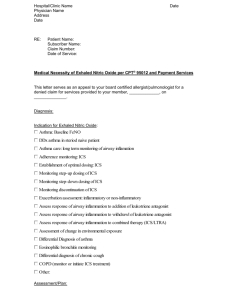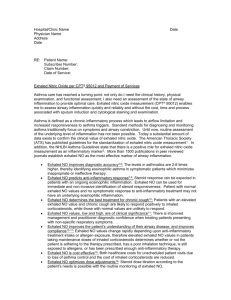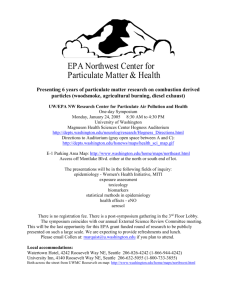Date - Aerocrine
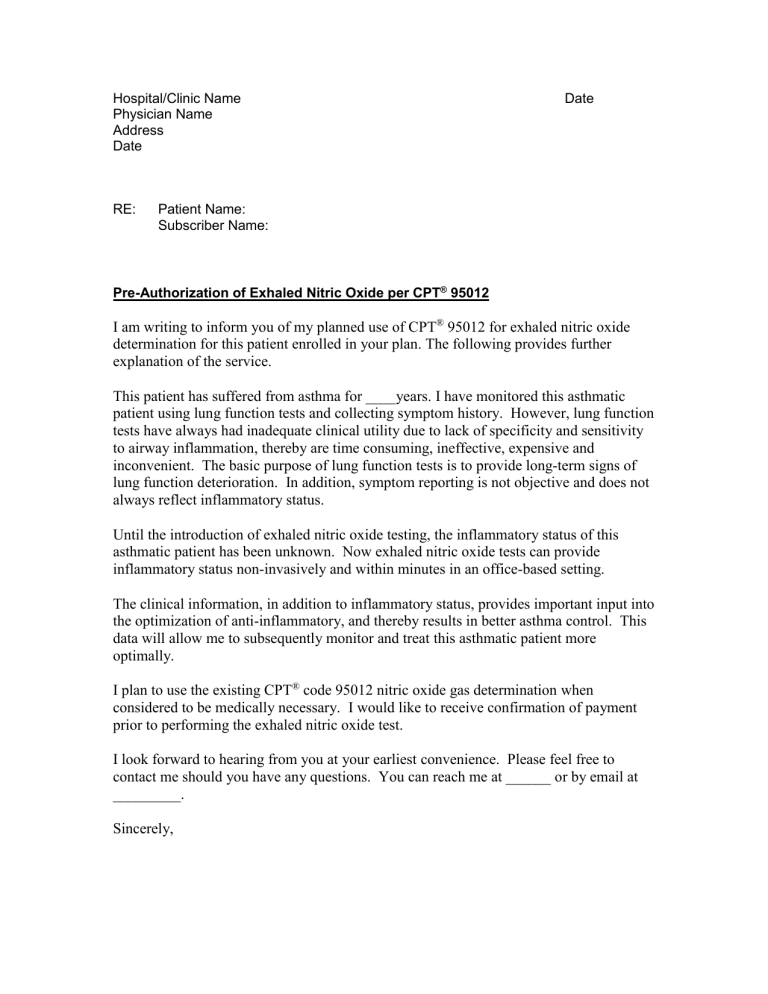
Hospital/Clinic Name
Physician Name
Address
Date
RE: Patient Name:
Subscriber Name:
Pre-Authorization of Exhaled Nitric Oxide per CPT
®
95012
Date
I am writing to inform you of my planned use of CPT
®
95012 for exhaled nitric oxide determination for this patient enrolled in your plan. The following provides further explanation of the service.
This patient has suffered from asthma for ____years. I have monitored this asthmatic patient using lung function tests and collecting symptom history. However, lung function tests have always had inadequate clinical utility due to lack of specificity and sensitivity to airway inflammation, thereby are time consuming, ineffective, expensive and inconvenient. The basic purpose of lung function tests is to provide long-term signs of lung function deterioration. In addition, symptom reporting is not objective and does not always reflect inflammatory status.
Until the introduction of exhaled nitric oxide testing, the inflammatory status of this asthmatic patient has been unknown. Now exhaled nitric oxide tests can provide inflammatory status non-invasively and within minutes in an office-based setting.
The clinical information, in addition to inflammatory status, provides important input into the optimization of anti-inflammatory, and thereby results in better asthma control. This data will allow me to subsequently monitor and treat this asthmatic patient more optimally.
I plan to use the existing CPT
®
code 95012 nitric oxide gas determination when considered to be medically necessary. I would like to receive confirmation of payment prior to performing the exhaled nitric oxide test.
I look forward to hearing from you at your earliest convenience. Please feel free to contact me should you have any questions. You can reach me at ______ or by email at
_________.
Sincerely,
________, MD
References:
1. ATS/ERS recommendations for standardized procedures for the online and offline measurement of exhaled lower respiratory nitric oxide and nasal nitric oxide, 2005. Am J Respir Crit Care Med. 2005
Apr 15;171(8):912-30.
2. NHLBI National Heart, Lung and Blood Institute. Expert Panel Report 3: Guidelines for the diagnosis and management of asthma
—full report 2007. August 28, 2007. Available at: www.nhlbi.nih.gov/guidelines/asthma/ asthgdln.pdf.
3.
Dressel H, de la Motte D, Reichert J, Ochmann U, Petru R, Angerer P, Holz O, Nowak D, Jörres RA,
Exhaled nitric oxide: Independent effects of atopy, smoking, respiratory tract infection, gender and height. Resp.
Med. 2008 Jul;102(7):962-9.
4. Malmberg LP, Petays T, Haahtela T, et al. Exhaled nitric oxide in healthy non-atopic school-age children: determinants and height-adjusted reference values. Pediatr Pulmonol 2006; 41: 635-42.
5. Smith AD, Cowan JO, Filsell S, McLachlan C, Monti-Sheehan G, Jackson P, Taylor DR. Diagnosing asthma
– Comparisons between exhaled nitric oxide measurements and conventional tests.
Am J
Respir Crit Care Med 2004;169:473-8.
6. Malmberg LP, Pelkonen AS, Haahtela T, Turpeinen M. Exhaled nitric-oxide rather than lung function distinguishes preschool children with probable asthma.
Thorax 2003;58:494-9.
7. Smith AD, Cowan JO, Brassett KP, Filsell S, McLachlan C, Monti- Sheehan G, Herbison GP, Taylor
DR. Exhaled nitric oxide: a predictor of steroid response. Am J Respir Crit Care Med 2005;172:453-9.
8. Zeiger RS, Szefler SJ, Phillips BR, Schatz M, Martinez FD, Chinchilli VM, Lemanske RF Jr, Strunk RC,
Larsen G, Spahn JD, Bacharier LB, Bloomberg GR, Guilbert TW, Heldt G, Morgan WJ, Moss MH,
Sorkness CA, Taussig LM; CARE Network of the NHLBI. Response profiles to fluticasone and montelukast in mild-to-moderate persistent childhood asthma.
J Allergy Clin Immunol. 2006
Jan;117(1):45-52.
9. Bratton DL, Lanz MJ, Miyazawa N, White CW, Silkoff PE. Exhaled nitric oxide before and after montelukast sodium therapy in school-age children with chronic asthma: A preliminary study. Pediatr
Pulmonol 1999;28:402-407.
10. Hahn PY, Morgenthaler TI, Lim KG. Use of exhaled nitric oxide in predicting response to inhaled corticosteroids for chronic cough. Mayo Clin Proc 2007; 82: 1350
–5.
11. Hewitt RS, Modrich CM, Medlicott T, Cowan JO, Taylor DR. Supporting the diagnosis of non-specific respiratory symptoms in primary care: the role of exhaled Nitric Oxide measurement and spirometry .
Prim Care Respir J; 2008 Apr; 17(2):97-103.
12. Silkoff PE, et al. The Aerocrine exhaled nitric oxide monitoring system NIOX is cleared by the US Food and Drug Administration for monitoring therapy in asthma.
J Allergy Clin Immunol 2004;114:1241-56.
13. Sorkness CA, Lemanske RF, Jr., Mauger DT, et al. Long-term comparison of 3 controller regimens for mild-moderate persistent childhood asthma: The Pediatric Asthma Controller Trial. J Allergy Clin
Immunol 2007; 119: 64-72.
14. Piacentini GL, Bodini A, Costella S, et al. Allergen avoidance is as sociated with a fall in exhaled nitric oxide in asthmatic children .
J Allergy Clin Immunol 1999;104:1323-4.
15. Delgado-Corcoran C, Kissoon N, Murphy SP, Duckworth LJ. Exhaled nitric oxide reflects asthma severity and asthma control.
Pediatr Crit Care Med 2004 Vol.5, No.1.
16. Stirling RG, Kharitonov SA, Campbell D, et al. Increase in exhaled nitric oxide levels in patients with difficult asthma and correlation with symptoms and disease severity despite treatment with oral and inhaled corticosteroids. Asthma and Allergy Group. Thorax 1998;53:1030-4.
17. Payne DN, Wilson NM, James A, Hablas H, Agrafioti C, Bush A. Evidence for different subgroups of difficult asthma in children.
Thorax 2001;56:345-50.
18. Berg J, Lindgren P. Economic evaluation of FENO measurement in diagnosis and 1-year management of asthma in Germany .
Respir Med 2008; 102: 219 –31.
19. Smith AD, Cowan JO, Brassett KP, Herbison GP, Taylor DR. Use of Exhaled Nitric Oxide
Measurements to Guide Treatment in Chronic Asthma.
N Engl J Med 2005;352:2163-73.
20. Pijnenburg MW, Hofhuis W, Hop WC, De Jongste JC. Exhaled nitric oxide predicts asthma relapse in children with clinical asthma remision. Thorax 2005;60:215-8.
Physician’s Current Procedural Terminology (CPT®) codes, descriptions and two-digit numeric modifiers are copyright ©2007 American Medical Association. All Rights Reserved.
